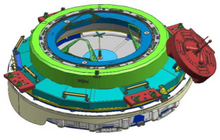International Docking System Standard
The International Docking System Standard ( IDSS ) is an international standard for coupling adapters on manned spaceships. It was defined by the International Space Station Multilateral Coordination Board in the joint work of the ISS partners NASA , Roskosmos , JAXA , ESA and the Canadian Space Agency .
The IDSS was originally created in 2010 and is intended to reduce the variety of existing coupling systems or to promote the creation of compatible systems. The first coupling maneuver in space took place in 2019 as part of the unmanned SpX-DM1 mission with a Dragon-2 spacecraft at the International Space Station (ISS) .
history
Before the IDSS , there were several different proposals for the standardization of the coupling nozzles, which in the end did not reach the operational readiness.
- LIDS coupling system
The LIDS system ( Low Impact Docking System ) was originally intended to expand the APAS-95 system on the ISS for the Orion spacecraft . Since the Orion spaceship is no longer to make flights to the ISS, this project has been discontinued.
- Common docking adapter
The Common Docking Adapter (CDA) was announced in 2009 and was planned as an adapter between the Common Berthing Mechanism and the NASA Docking System at the time . It was planned that the CDAs would be brought to the ISS by the Japanese HTV and attached directly to Node-2.
design
The IDSS defines an androgynous coupling system in which both sides are identical. One side takes on the active role, while the other acts passively. The mechanism can be controlled autonomously as well as manually. The coupling system enables the exchange of crew, cargo, power and data. In the future it should also be possible to transfer water, fuel and compressed air.
The inner diameter for the transfer of crews and cargo is 800 mm.
In contrast to some other developments in this area, the standard stands under public domain . It can therefore be used by all spacecraft manufacturers without any patent hurdles.
Executions
The NASA Docking System (NDS) is NASA's implementation of the IDSS. With the International Docking Adapter (IDA) , after the loss of IDA-1 at launch in 2015, existing APAS-95 coupling nozzles on the US part of the ISS were converted to the IDSS standard in 2016 with IDA-2 and in 2019 with IDA-3.
The European Space Agency (ESA) is planning a system called International Berthing and Docking Mechanism (IBDM) , which is also compatible with IDSS. The first use should take place on the Dream Chaser .
Spaceships and stations with IDSS sockets
The following spaceships and space stations use IDSS-compatible coupling nozzles:
- International Space Station: at IDA-2 (since 2016) and IDA-3 (since 2019)
- Dragon 2: First flight in 2019 with docking on the ISS
- CST-100 : The first coupling to the ISS planned for 2019 did not take place due to the course of the mission.
- Dream Chaser: planned (as of 2019)
Web links
- www.internationaldockingstandard.com Website of the standard
swell
- ↑ International Docking Standard. Multilateral Coordination Board (MCB), accessed on February 2, 2016 .
- ↑ Recovery Act: United States On-orbit Segment Phase II Development of International Space Station Common Docking Adapter . SpaceRef. October 7, 2009. Retrieved August 19, 2016.
- ↑ a b Skip Hatfield: NASA Docking System (NDS) Technical Integration Meeting . NASA. November 17, 2010. Retrieved August 19, 2016.
- ↑ Questions & Answers. Retrieved on January 7, 2019 (English): “2. Why have you placed this standard in the public domain? In order for an international standard to be used it needs to be freely available to interested companies and space agencies. "
- ↑ Europe to invest in Sierra Nevada's Dream Chaser cargo vehicle. SpaceNews.com, January 22, 2016, accessed January 11, 2020 .

